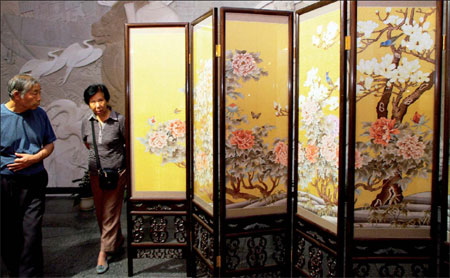Once used as draft shields by the wealthy and poetry boards by the emperor, temporary wooden-framed divides have been a feature of Chinese homes for centuries and are now the latest trend in interior design.

A Chinese screen is showcased at an intangible cultural heritage exhibition in Beijing. Deng Yifei / for China Daily
Interior design is big business in China today, with wealthy homebuyers ready to pay for expert advice on where to place their furniture or which wallpaper to choose. In a country that has been racing to develop over the past 30 years and where old courtyard buildings have been torn down to make way for skyscrapers, you might expect ultra modern to be the flavor of the times. But among China's interior designers the latest trend is something from the country's distant past - screens.
Increasingly, families are using Chinese screens not just as a functional divide, but also as an artistic addition to their homes.
"While some customers stick to an archaic style to make an abrupt contrast between the modern and the ancient, others prefer to make tweaks to adapt to the existing appearance of a room," says Wu Di, an interior designer at Beijing Dupa Furniture.
"There is no rigid formula for screens anymore; some people love the feel of formality and some place great emphasis on individuality. I say each to their own.
"One of my clients wanted me to choose a screen to put beside her white rocaille cedar upholstered armchair. The entire room gives out a whitish and sober feel, so I picked a white wooden folding screen with a hollowed out flower-de-luce pattern. I personally think this outlines the sanctity of the white color."
A Chinese screen usually consists of several panels that are joined by hinges. Their design is both practical and artistic, Wu says. They can be folded for storage, and when expanded they provide a "divided yet not secluded" effect, he says, as well as catching the light in interesting ways.
There are also single-panel screens, often used in areas such as hotel entrances and meeting rooms. These are sometimes painted with Chinese landscapes to create a point of brightness and interest, he says.
In November an embroidery workshop in Suzhou, Jiangsu province, completed a landing screen with Burma rosewood frames inlaid with a large local embroidery fabric that measured 472 centimeters by 275 centimeters.
By interweaving different light and heavy colored silk thread through cross-stitching, the design is rendered with a freshness that offsets the stiffness and bulkiness of the single-panel screen.
Screens were first designed as draft shields and were often placed at the edge of a bed, to help give a better night's sleep.
A variety of designs and materials was used in their construction, but most early versions unearthed from Western Han Dynasty (206 BC-AD 24) tombs have wooden frames and silk paneling.
The first single-panel screen dates back to the Eastern Zhou Dynasty (770-256 BC). It was not until the Han Dynasty (206 BC-AD 220) that folding screens first appeared.
Early themes for screen decorations included pictures from mythology, imperial life and landscapes.





Why not rent a boyfriend, or girlfriend to please parents during the Spring Festival?